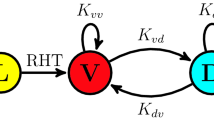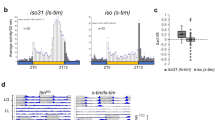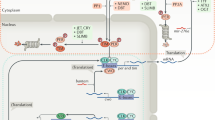Abstract
A TWO-DIMENSIONAL limit cycle model (Fig. 1) predicts the behaviour in darkness of both the Drosophila pseudoobscura circadian eclosion rhythm1,2 and the mosquito Culex pipiens quinquefasciatus Say (C p. fatigans Wied.) flight activity rhythm3,4. This model has been extended to explain features of rhythms in very dim light, but in constant ‘bright’ light it has been suggested that the dynamics are fundamentally different, with the system having a globally stable equilibrium point and hence no stable oscillation1. We propose here a simplifying modification: for each light intensity the dynamics are topologically equivalent, and thus for each there is a limit cycle, its position and amplitude being continuous functions of intensity. This interpretation avoids the awkward discontinuity between ‘light’ and ‘dark’ dynamics and emphasises the possibility of time-keeping at all light intensities. Furthermore, it provides a simple explanation for novel features of the Culex rhythm described here and previously3, and allows us to treat some important differences between Culex and Drosophila as merely quantitative. Finally, it suggests a new general strategy for the analysis of circadian rhythms and allows extensions of established theory that explain previously paradoxical results obtained for the two species (E.L.P. in preparation).
This is a preview of subscription content, access via your institution
Access options
Subscribe to this journal
Receive 51 print issues and online access
$199.00 per year
only $3.90 per issue
Buy this article
- Purchase on Springer Link
- Instant access to full article PDF
Prices may be subject to local taxes which are calculated during checkout
Similar content being viewed by others
References
Pavlidis, T. Lectures on Mathematics in the Life Sciences Vol. 1 (ed. Gerstenhaber, M.) 88–112 (Am. Math. Soc., Providence, Rhode Island, 1968).
Winfree, A. T. J. theor. Biol. 28, 327–374 (1970), J. comp. Physiol. 85, 105–140 (1973), Science 183, 970–972 (1974).
Jones, M. D. R. Nature 261, 491–492 (1976).
Peterson, E. L. Behaviour (in the press).
Pittendrigh, C. S. Z. Pflanzenphysiol. 54, 275–307 (1966).
Pittendrigh, C. S. The Molecular Basis of Circadian Rhythms (eds Hastings, J. W. & Schweiger, H-G.) 85–108 (Dahlem Konferenzen, Berlin, 1976).
Pavlidis, T. Bull. math. Biol. 40, 625–635 (1978), 675–692 (1978).
Author information
Authors and Affiliations
Rights and permissions
About this article
Cite this article
PETERSON, E., JONES, M. Do circadian oscillators ever stop in constant light?. Nature 280, 677–679 (1979). https://doi.org/10.1038/280677a0
Received:
Accepted:
Issue Date:
DOI: https://doi.org/10.1038/280677a0
This article is cited by
-
TheParamecium circadian clock: a phase-plane analysis of entrainments by discrete changes in light intensity and continuous light involved in a light/dark cycle
Experientia (1988)
-
Mosquito circadian and circa-bi-dian flight rhythms: a two-oscillator model
Journal of Comparative Physiology A (1984)
-
Dynamic response of a circadian pacemaker
Biological Cybernetics (1981)
-
Phase-resetting a mosquito circadian oscillator
Journal of Comparative Physiology ? A (1980)
Comments
By submitting a comment you agree to abide by our Terms and Community Guidelines. If you find something abusive or that does not comply with our terms or guidelines please flag it as inappropriate.



